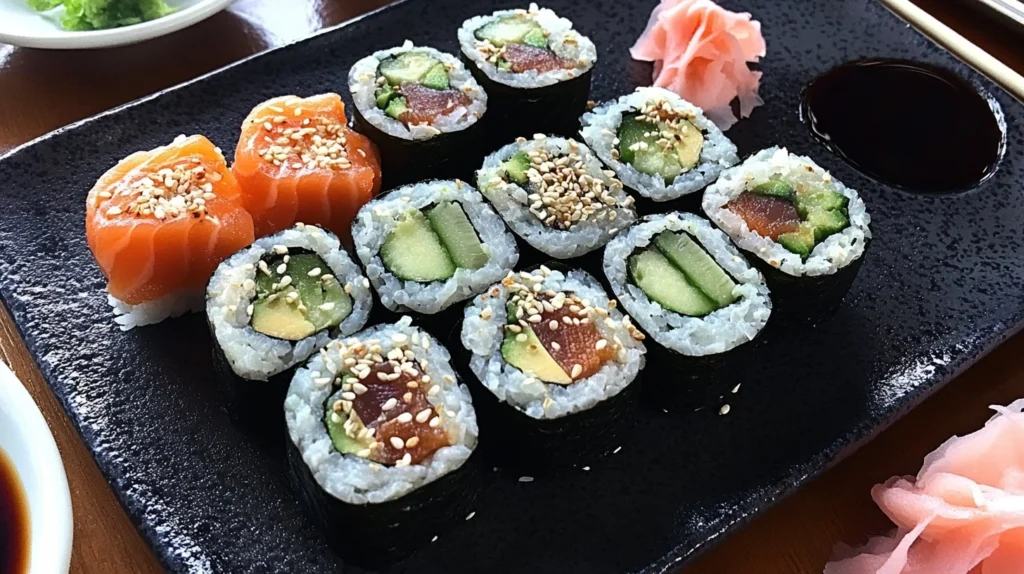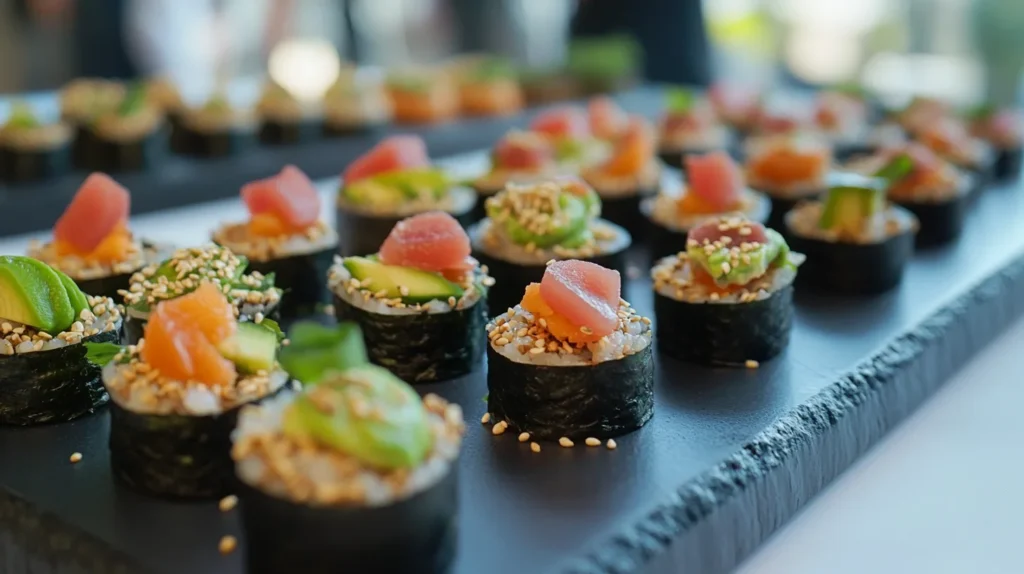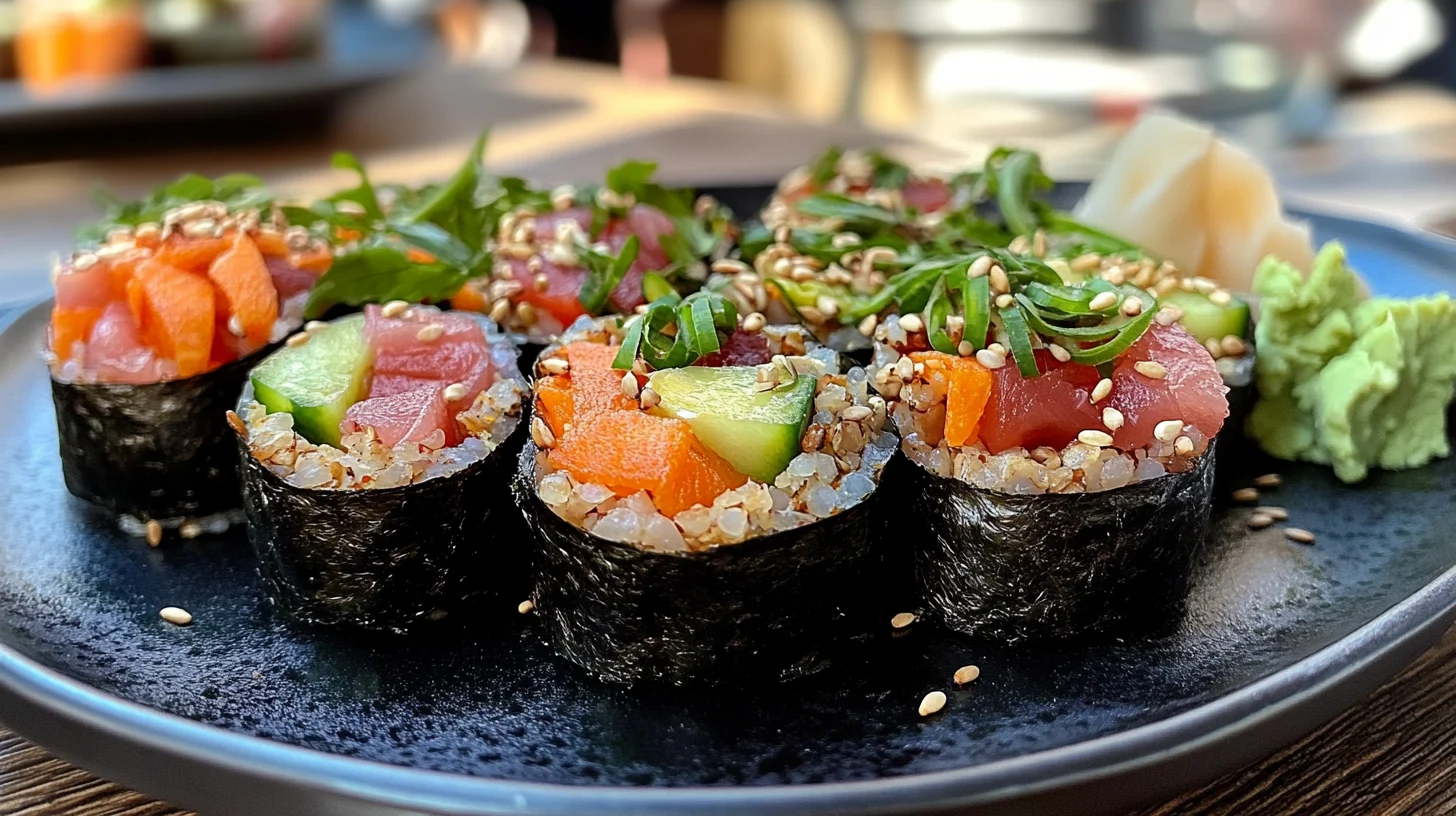What Are the Healthiest Sushi Rolls? Discover Nutritious and Delicious Options
What Are the Healthiest Sushi Rolls? This query often arises for those who wish to indulge in sushi while maintaining a balanced diet. With its unique blend of flavors, textures, and nutrients, sushi can be a healthy dining choice when selected thoughtfully. Let’s dive deeper into understanding the components that contribute to the healthiness of various sushi rolls and how you can make informed choices whether you’re dining out or making sushi at home.
Craving a healthier sushi option? Explore our Low Sodium Sushi Meal Recipes for delicious and flavorful ideas that won’t compromise your health. Click here to read more!
Understanding Sushi: A Nutritional Perspective
Before we can identify which sushi rolls are the healthiest, it’s essential to understand what makes up sushi from a nutritional perspective. The combination of ingredients, preparation methods, and portion sizes play significant roles in determining the overall healthfulness of sushi.
The Basics of Healthiest Sushi Ingredients
Healthiest Sushi is a Japanese dish traditionally made with vinegared rice, raw fish, and vegetables. While the core elements of sushi remain consistent across variations, the choice of ingredients can greatly influence its nutritional profile.
Rice serves as the base of most sushi rolls, providing carbohydrates that offer energy. The type of rice used, and how it’s prepared, can significantly affect the dish’s health benefits. In addition to rice, various seafood options are included, which can provide high-quality protein, omega-3 fatty acids, vitamins, and minerals. Vegetables bring additional fiber and nutrients, enhancing overall health benefits.
Nutritional Benefits of Common Healthiest Sushi Components
When evaluating sushi’s healthiness, it’s crucial to consider the individual components.
White rice is commonly used in sushi rolls and is primarily a source of carbohydrates. However, it lacks fiber and essential nutrients found in whole grains. To improve the health value, brown rice or alternative grains can be employed, offering more fiber and beneficial nutrients.
Fish is a staple ingredient in sushi, and various types contribute different health benefits. Fatty fish like salmon and mackerel are rich in omega-3 fatty acids, known for supporting heart health and reducing inflammation. Leaner fish such as tuna provide high-quality protein with lower fat content, making them an excellent choice for health-conscious diners.
Vegetables, often overlooked, can elevate a sushi roll’s nutritional value. They provide essential vitamins, minerals, and antioxidants that support overall health. Incorporating a variety of colorful vegetables not only boosts nutrition but also adds freshness and crunch to the rolls.
The Role of Rice in Sushi
Rice is arguably the backbone of any sushi roll. It provides structure and is often flavored with vinegar, sugar, and salt, enhancing its taste while balancing the flavors of seafood and vegetables.
Choosing between white and brown rice can significantly affect health outcomes. Brown rice contains more fiber, which aids digestion and promotes satiety. It also has higher levels of essential nutrients like magnesium and B vitamins, which are stripped away during the milling process of white rice.
The portion of rice used in sushi should also be considered. Many sushi rolls come with generous servings of rice, which can increase carbohydrate intake significantly. Opting for rolls with less rice or choosing hand rolls and sashimi can help control calorie count while still enjoying the flavors.

Identifying Healthiest Sushi Rolls
With a clearer understanding of sushi’s nutritional components, we can now explore which sushi rolls stand out as healthier options. Various traditional and creative choices cater to diverse dietary needs and preferences.
Classic Healthy Choices
Classic sushi rolls such as nigiri and sashimi are often among the healthiest available. Nigiri features a small bed of rice topped with fresh fish, while sashimi consists solely of thinly sliced fish without rice. Both options highlight the quality of the fish, allowing its natural flavors to shine through without excess calories from rice or sauces.
Additionally, rolls that incorporate avocado, cucumber, or other fresh vegetables offer a balance of flavors and textures while upping the nutritional ante. Rolls such as the California roll, which includes imitation crab and avocado, provide a delicious yet relatively healthy option, especially when paired with a side of seaweed salad or edamame.
Creative and Nutritious Roll Options
As sushi has evolved, chefs have developed creative rolls that prioritize health without sacrificing flavor. These innovative rolls often feature unique ingredients and combinations designed to enhance both taste and nutrition.
For example, a rainbow roll—typically consisting of assorted fish on top of a California roll—brings diversity and a range of nutrients from different seafood. The addition of vegetables like bell peppers or sprouts can further boost the nutrient content, creating a satisfying and healthful meal.
Another popular option is the spicy tuna roll, which combines fresh tuna, spicy mayo, and cucumber. While traditional versions might include high-calorie sauces, a healthier rendition can be achieved by substituting spicy mayo with sesame oil or avoiding heavy sauces altogether.
Vegetarian and Vegan Sushi Rolls
Vegetarian and vegan sushi rolls are gaining popularity as more individuals adopt plant-based diets. These options are typically packed with a variety of vegetables, grains, and legumes, providing ample nutrients without relying on animal products.
Common ingredients in vegetarian sushi include cucumbers, carrots, avocados, sweet potatoes, and tofu. For instance, a tempura vegetable roll features lightly battered and fried vegetables, providing crispy texture while remaining nutritious. Additionally, sushi made with quinoa instead of rice can offer increased protein and fiber levels.
Vegan sushi alternatives can even include fruits like mango or pineapple, adding a sweet twist to the rolls. With creativity, plant-based sushi can be just as satisfying and flavorful as traditional fish-based varieties.
Low-Calorie Sushi Alternatives
Many sushi establishments offer low-calorie alternatives aimed at health-conscious consumers. These sushi options typically replace higher-calorie ingredients with lighter alternatives, making them suitable for anyone monitoring their caloric intake.
For instance, sushi rolls that use lettuce wraps instead of rice provide a refreshing and light alternative that reduces carbohydrate content. Furthermore, sashimi-style dishes allow diners to enjoy the delicate flavors of fish without the added calories of rice.
It’s important to be mindful of sauces and dressings that accompany sushi. Many sauces can be deceptively high in calories and sugars. Choosing soy sauce or wasabi over creamy mayonnaise-based sauces can help maintain a lower calorie count while still delivering robust flavors.
Key Ingredients for Healthier Sushi Rolls
To make informed choices about sushi rolls, it’s crucial to understand key ingredients that contribute to healthiness. By selecting specific elements, you can create or order rolls that align with your dietary goals.
Lean Proteins in Sushi
Protein is essential for building and repairing tissues, and the type of protein you choose in your sushi rolls can make a big difference. Lean proteins like fish and shellfish are excellent sources of high-quality protein without excessive saturated fats.
Opting for fish such as tuna, salmon, or shrimp can offer omega-3 fatty acids and vital nutrients while keeping calorie counts reasonable. Avoiding deep-fried options, such as tempura shrimp, can also help maintain a leaner protein profile for your sushi rolls.
For plant-based diets, consider incorporating ingredients like tofu or tempeh, which provide plant-based protein with numerous health benefits, including promoting heart health and muscle repair.
Whole Grain and Alternative Rice Options
As previously discussed, the type of rice plays a crucial role in sushi’s overall healthfulness. Choosing whole grain or alternative rice options can profoundly impact your sushi experience.
Brown rice is a popular alternative due to its higher fiber content and whole grain benefits. Some sushi restaurants may even offer sushi made with quinoa or cauliflower rice, which are great options for those looking to reduce carbohydrates further.
These alternatives not only enhance the nutritional value of sushi rolls but also introduce new textures and flavors that can elevate the overall dining experience.
Fresh Vegetables: Enhancing Nutrition
Incorporating fresh vegetables into sushi rolls is one of the simplest ways to boost their nutritional profile. Vegetables add essential vitamins, minerals, and fiber, contributing to overall health and well-being.
Consider adding vibrant vegetables like avocado, cucumber, carrots, and bell peppers to your sushi. Avocado, for instance, is an excellent source of healthy fats, while cucumbers provide hydration and crunch. These ingredients not only enhance the visual appeal of sushi but also improve nutritional density.
Furthermore, using seasonal vegetables allows for greater variety and creativity in sushi rolls. Switching up ingredients based on availability can lead to exciting new flavor profiles.
Healthy Fats: Avocado and Beyond
Healthy fats play a significant role in a balanced diet, and sushi can be an excellent vehicle to deliver these beneficial fats. Avocado stands out as a common ingredient in many sushi rolls, providing monounsaturated fats that promote heart health.
Beyond avocado, consider incorporating nuts and seeds, such as sesame seeds or crushed peanuts, to enhance flavor and texture while adding additional healthy fats. These ingredients not only contribute richness but also provide crucial nutrients such as vitamin E and magnesium, which support overall health.

Making Healthier Sushi at Home
While enjoying sushi at restaurants is delightful, making sushi at home provides the chance to customize your rolls according to your dietary requirements and personal preferences. With a few basic tools and ingredients, you can craft delicious and nutritious sushi rolls right in your kitchen.
Essential Tools and Ingredients for Homemade Sushi
To prepare sushi at home, you’ll need some essential tools. A bamboo sushi mat is fundamental for rolling, ensuring even pressure and tightness. You’ll also require a sharp knife for slicing your rolls cleanly and a rice cooker or pot to prepare your rice perfectly.
As for ingredients, focus on high-quality sushi-grade fish, fresh vegetables, and alternative rice options if desired. Stocking up on nori (seaweed sheets), soy sauce, wasabi, and pickled ginger is also important for authenticity.
By utilizing fresh ingredients and thoughtful preparation methods, you can create healthy sushi options tailored to your tastes while controlling portions and additives.
Step-by-Step Guide to Crafting Healthy Rolls
Making sushi at home can be a fun and rewarding experience. To start, prepare your rice according to package instructions, allowing it to cool before use.
Lay a sheet of nori on your sushi mat and spread a thin layer of rice over it, leaving space at the edges for rolling. Add your chosen fillings—be it fish, vegetables, or other ingredients—along the center, being careful not to overfill.
Using the sushi mat, gently roll the nori away from you while applying even pressure, sealing the edge with a little water. Once rolled, slice into bite-sized pieces with a sharp knife, serving with soy sauce for dipping. Enjoy the satisfaction of creating a healthy meal from scratch!
Tips for Choosing Nutrient-Dense Fillings
Selecting the right fillings is crucial for crafting a healthful sushi roll. Focus on incorporating a mix of lean proteins, fresh vegetables, and healthy fats.
Experiment with various combinations to keep things interesting and nutritionally balanced. For example, pairing smoked salmon with avocado and cucumber offers a delicious medley of flavors and nutrients, while tempura vegetables can add a satisfying crunch to your rolls.
Don’t shy away from experimenting with spices or herbs, as they can elevate flavors without adding extra calories. Fresh herbs like cilantro or chives can add depth and freshness, making your homemade sushi even more enjoyable.
Balancing Flavor with Nutrition
When creating sushi rolls, it’s essential to strike a balance between flavor and nutritional value. Consider using umami-rich ingredients, such as miso or sesame oil, to enhance taste without relying on high-calorie sauces.
Marinating fish or vegetables can also infuse additional flavor while still keeping health in mind. Techniques such as grilling or steaming can preserve nutrients while adding complexity to dishes.
Ultimately, the process of crafting sushi at home allows you to take control of both flavor and healthfulness, ensuring each bite is satisfying and nourishing.
Conclusion
Navigating the world of sushi doesn’t have to be daunting; understanding the components that contribute to healthiness can empower you to make informed choices. From classic rolls to creative adaptations and plant-based options, there’s no shortage of delicious and nutritious sushi available.
Whether you’re dining out or crafting your own at home, prioritizing lean proteins, fresh vegetables, healthy fats, and alternative grains can elevate your sushi experience while supporting your health. So next time you’re pondering What Are the Healthiest Sushi Rolls?, remember that with the right knowledge and a bit of creativity, indulging in sushi can align beautifully with your nutritional goals. Enjoy the journey of exploration in sushi-making and savor every bite!


2 Comments-
Pingback: Low Sodium Sushi Meal Recipes – Healthy & Flavorful Ideas
-
Pingback: Discover the Irresistible Spanish Rice Recipe That Everyone Will Love